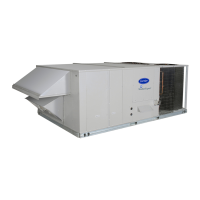Do you have a question about the Carrier 48HJD012 and is the answer not in the manual?
Lists key advantages and features of the rooftop units, including efficiency, reliability, and ease of maintenance.
Discusses scroll compressors, fan motors, coil technology, and overall unit performance.
Explains the structure and meaning of the model numbers for unit identification.
Details cooling capacities, SEER, EER, IPLV, and heating efficiencies by model.
Lists available factory-installed options and field-installed accessories for customization.
Guides through determining unit loads based on design conditions.
Calculates the required rooftop cooling load.
Selects the unit based on mixed air conditions and cooling load.
Determines the required net heating capacity for the unit.
Calculates the net cooling capacity, accounting for fan heat.
Details electrical data including RLA, FLA, MCA, and MOCP for unit power.
Provides cooling capacities for 3-ton units at various conditions.
Provides cooling capacities for 5-ton units at various conditions.
Provides cooling capacities for 7.5 and 8.5-ton units at various conditions.
Provides cooling capacities for 10 and 12.5-ton units at various conditions.
Cooling capacities for 3-ton units with MoistureMiser option.
Cooling capacities for 5-ton units with MoistureMiser option.
Cooling capacities for 6-ton units with MoistureMiser option.
Cooling capacities for 7.5 and 8.5-ton units with MoistureMiser.
Electrical data for standard motor units without convenience outlet.
Electrical data for standard motor units with convenience outlet.
Electrical data for high-static motor units without convenience outlet.
Electrical data for high-static motor units with convenience outlet.
Explains cooling sequence for units without economizers.
Describes heating sequence for units without economizers.
Explains heating sequence with economizer/two-position damper.
Explains operation of the MoistureMiser dehumidification package.
Details unit controls and safety features.












